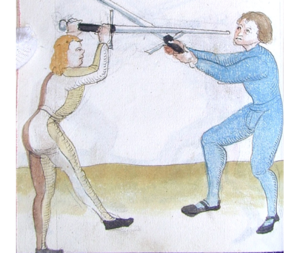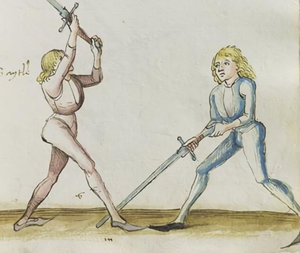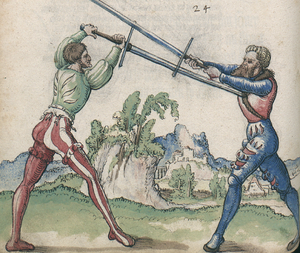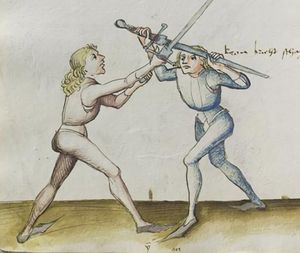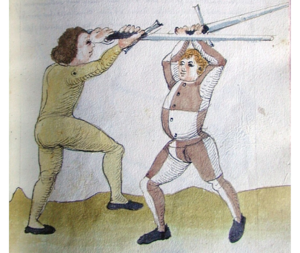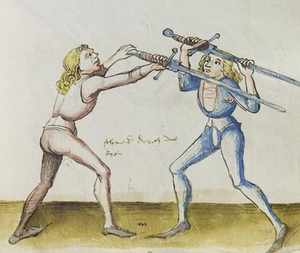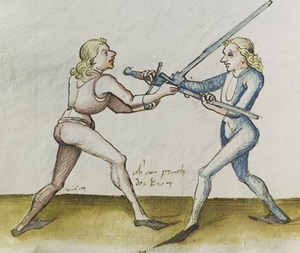|
|
You are not currently logged in. Are you accessing the unsecure (http) portal? Click here to switch to the secure portal. |
Difference between revisions of "Case Study:Schaydelhaw"
| Line 3: | Line 3: | ||
|- | |- | ||
! <p>Images<br/>from Glasgow and Goliath</p> | ! <p>Images<br/>from Glasgow and Goliath</p> | ||
| − | ! <p>Sigmund ain Ringeck<br/>by [[Christian Trosclair]]</p> | + | ! <p>[[Sigmund ain Ringeck]]<br/>by [[Christian Trosclair]]</p> |
! <p>Images<br/>from Cluny</p> | ! <p>Images<br/>from Cluny</p> | ||
| − | ! <p>Hans Seydenfaden von Erfurt<br/>by [[Christian Trosclair]]</p> | + | ! <p>[[Hans Seydenfaden von Erfurt]]<br/>by [[Christian Trosclair]]</p> |
|- | |- | ||
| Line 30: | Line 30: | ||
|} | |} | ||
<p>'''Gloss''': Initiate a hew straight above from the top of the head with the long edge, and swiftly upon that, an under-hew to the right side of his head. Thereafter according to the two plays in his school rules with other strikes, treads and deception.</p> | <p>'''Gloss''': Initiate a hew straight above from the top of the head with the long edge, and swiftly upon that, an under-hew to the right side of his head. Thereafter according to the two plays in his school rules with other strikes, treads and deception.</p> | ||
| + | |||
| + | |- | ||
| + | | colspan="4" | <hr/> | ||
|- | |- | ||
| Line 36: | Line 39: | ||
| | | | ||
| | | | ||
| + | |||
| + | |- | ||
| + | | colspan="4" | <hr/> | ||
|- | |- | ||
| Line 53: | Line 59: | ||
| ''What comes from him, <br/> the crown takes away.'' | | ''What comes from him, <br/> the crown takes away.'' | ||
|} | |} | ||
| − | <p>'''Gloss''': When you hew-in above with the scalper, if he then displaces high with the sword gripped with an | + | <p>'''Gloss''': When you hew-in above with the scalper, if he then displaces high with the sword athwart over the head or gripped with an armored hand, that is called the crown against Seydenfaden's scalper, and with that run-in with shoving, etc. It also takes-off the scalper. This also breaks someone like this again as above with the hilt thrown over that and cast down.</p> |
| + | |||
| + | |- | ||
| + | | colspan="4" | <hr/> | ||
|- | |- | ||
| Line 66: | Line 75: | ||
| Press the strike,<ref>D. ''stuch'', R. ''stich'': "press the thrust".</ref><br/> Withdraw it with cutting. | | Press the strike,<ref>D. ''stuch'', R. ''stich'': "press the thrust".</ref><br/> Withdraw it with cutting. | ||
|} | |} | ||
| − | <p>{{red|b=1|Gloss}}. Note, when he displaces the parter (or otherwise another hew) with the crown and with that runs in: so take the under-cut below his hands into his arm and press firmly upwards (as stands pictured next to this); so the crown is broken | + | <p>{{red|b=1|Gloss}}. Note, when he displaces the parter (or otherwise another hew) with the crown and with that runs in: so take the under-cut below his hands into his arm and press firmly upwards (as stands pictured next to this); so the crown is well broken...</p> |
| − | | [[File:MS CL23842 028r | + | | [[File:MS CL23842 028r-detail.png|300x300px|center|border]] |
| <p>'''Another play. How the cut breaks the crown.'''<br/><br/></p> | | <p>'''Another play. How the cut breaks the crown.'''<br/><br/></p> | ||
{| class="zettel" | {| class="zettel" | ||
| Line 77: | Line 86: | ||
| ''Press the strike. <br/> It backs-off with cutting.'' | | ''Press the strike. <br/> It backs-off with cutting.'' | ||
|} | |} | ||
| − | <p>'''Gloss''': When he displaces the scalper (or otherwise a hew) with the armed crown and with that runs-in, then take the cut under his hands, into his arms and press firmly upward | + | <p>'''Gloss''': When he displaces the scalper (or otherwise a hew) with the armed crown and with that runs-in, then take the cut under his hands, into his arms and press firmly upward...</p> |
| + | |- | ||
| + | | colspan="4" | <hr/> | ||
| + | |||
| + | |- | ||
| + | | | ||
| + | | <p>...and wind your sword from the under-cut into the over-cut, and with that withdraw yourself.</p> | ||
| + | | [[File:MS CL23842 028v-detail.png|300x300px|center|border]] | ||
| + | | <p>...and with the stroke back yourself off with it.</p> | ||
|} | |} | ||
</div> | </div> | ||
Revision as of 12:42, 15 July 2017
Images |
Images |
||||||||||
|---|---|---|---|---|---|---|---|---|---|---|---|
[54] This is the text and the gloss about the parter, and about the plays thereof
Gloss. Here note the parter is really dangerous to the face and to the chest; deploy it thusly: When he stands against you in the guard [of] the fool, hew above with the long edge, down from your[3] part to his head, and with the hew remain high with the arms and if he displaces, so hang-in[4] to him with the point, with the long edge above his hilt, and thrust him to the face (as stands pictured hereafter next to this). |
The squinter with scalper with it's plays
Gloss: Initiate a hew straight above from the top of the head with the long edge, and swiftly upon that, an under-hew to the right side of his head. Thereafter according to the two plays in his school rules with other strikes, treads and deception. | ||||||||||
If he then shoves the point firmly upward with his hilt in the displacement of the parter, invert your sword with the hilt high[6] in front of your head (such that the thumb comes below), and set the point under his hands upon his chest (as stands pictured here). |
|||||||||||
[56] How the crown breaks the parter
Gloss. Note, when you cleave-in above with the parter: if he displaces with the hilt high over his head, this displacement is called the crown, and with it [he] runs-in to you. |
Another play. How the crown breaks the scalper.
Gloss: When you hew-in above with the scalper, if he then displaces high with the sword athwart over the head or gripped with an armored hand, that is called the crown against Seydenfaden's scalper, and with that run-in with shoving, etc. It also takes-off the scalper. This also breaks someone like this again as above with the hilt thrown over that and cast down. | ||||||||||
[57] This is the text and the gloss: how the cut breaks the crown
Gloss. Note, when he displaces the parter (or otherwise another hew) with the crown and with that runs in: so take the under-cut below his hands into his arm and press firmly upwards (as stands pictured next to this); so the crown is well broken... |
Another play. How the cut breaks the crown.
Gloss: When he displaces the scalper (or otherwise a hew) with the armed crown and with that runs-in, then take the cut under his hands, into his arms and press firmly upward... | ||||||||||
...and wind your sword from the under-cut into the over-cut, and with that withdraw yourself. |
...and with the stroke back yourself off with it. | ||||||||||
- ↑ Kehr has two etymologies: one is "to turn", the other is "to sweep away" or to "carry off"; the gloss supports the first derivation.
- ↑ Alternately: strongly, firmly, steadfastly.
- ↑ D. der lange: "long, high, tall, or lofty".
- ↑ einhangen: to adhere, stick to, cleave to, hold on to, engage deeply.
- ↑ Alternately: strongly, firmly, steadfastly.
- ↑ S. fast vber sich: "firmly upward".
- ↑ D., G. Schon, lit. "already", "yet".
- ↑ D. stuch, R. stich: "press the thrust".

